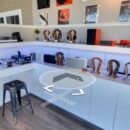Audio mastering has come a long way since the days of mechanical recordings and magnetic tape. Today audio professionals are responsible for managing complex digital projects that incorporate thousands of tracks within a complete record.
For Maor Appelbaum, a Los Angeles-area mastering engineer whose credits include Lupe Fiasco, Faith No More, Meatloaf and Yes, the key to producing a good sounding record is balance of experience, quality equipment and good songs.
“People like to say it’s not the gear, it’s the ear. But without the right gear, there may be limitations,” says Appelbaum. “I work with and have tried a lot of gear. So I experiment and look for what is a good fit and brings the desired sound for the specific project.”
Helping him perform his job to meet the critical demands of artists such as Yngwie Malmsteen, Halford, Walter Trout, Adrenline Mob and many others is his Furman power conditioning equipment that ensures his studio runs smoothly around the clock and under all conditions.
Through the rapid evolution of technology, every studio is an evolving workspace. In Appelbaum's case, his studio has to keep up with the latest market trends. Recently he added three pieces of gear he says increase his ability to minimize line noise, protect against power surges and spikes, improve clarity and dynamics, and maintain the integrity of his hard work.
Furman Tower of Power
“I call it my tower of power,” he says. “The first piece I purchased was the Furman Elite-20 PFi linear power source, and I was amazed how much it helped clean up unwanted noise when mastering. About eight months later, I added the Furman SPR20i voltage regulator and the P-2400 IT symmetrically balanced power conditioner to lower the noise floor as much as possible, enhance surge protection and improve playback detail.”
All the electricity in Appelbaum’s studio now runs through the Furman equipment starting with the SPR20i. Stable regulated AC power then goes to the Elite 20PFi, where AC is split into two sections—one through Furman’s low impedance power factor technology for the monitors and amps, and the other to the P-2400 IT.
From there, the P-2400 IT Balanced Power unit feeds the rest of the studio equipment, including a Maselect analog console, as well as equipment from TC Electronic, Rupert Neve, Manley Labs, Bryston and PMC Speakers.
Gallery: Furman Products Working Hard in the Studio
“In mastering, every bit of improved clarity makes a huge impact on the final product,” notes Appelbaum. “With this gear I can crank up the monitors without hearing line noise. It also helps to make the transmission pure by ensuring every piece of gear operates at its optimal level. I work seven days a week, often in long stretches, so one of the most important factors for me is that everything works 100 percent of the time. After thousands of hours, I can trust my Furman gear to keep my studio running.”
In addition to the product’s technical advantages, Appelbaum emphasizes the level of customer support that Furman has provided is equally as important.
“Michael Anderson [at Furman] did a great job explaining what different components do and how they can work together,” says Appelbaum. “He was instrumental in my decisions to switch to Furman after using other brands in the past. It’s a major benefit to have someone who is there to answer questions and explain things.”
Besides the protection and voltage consistency the Furman products deliver, another advantage of his new setup is that every Furman product is designed to minimize noise during operation.
“When I began trying to lower the noise floor of my studio and workspace, I was hoping to improve clarity,” he adds. “After doing this, I now feel more movement in the audio, it sounds better and reacts to my adjustments better. I hear more dynamics, improved clarity, and better separation and width, which often means I can do less alteration to achieve a perfect product.”















